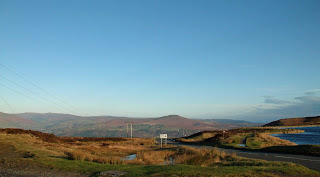
This is one of my favourite places on the planet. It is a magical fairy castle, built in the late 1800s on top of, and using the foundations of, earlier castles on the site. William Burgess took the original floor plans of earlier buildings and constructed this magnificent edifice on top. He researched medieval castles and built his own version, but with fantastically decorated interiors. Even visiting on a bleak, very rainy day with gale force winds battering em didn't diminish my enthusiasm! The castle sits in woodland on a hillside overlooking Cardiff, and can be seen from the nearby motorway, looking ethereally beautiful.

A closer view of the two towers.

The front of the castle - can you imagine trying to get into this place uninvited? The ramp up to the castle is part ramp, but the top part is a drawbridge. There is no moat, but there is a big ditch!

The red wooden structure high above the door is called a hourd - it is a place where people defending the castle could drop/throw heavy objects, boiling oil, flaiming arrows etc onto unwary attackers.

The doorbell!!!!

An arrow slit on the upper floor - these long thin slits allowed archers to fire arrows at attackers whilst keeping themselves relatively safe.

The portcullis, hanging above the doorway. If castles were attacked, they dropped the portcullis so the attackers couldn't get to the main doors with axes or fire.

In the ceiling, either side of the portcullis, are 'murder holes'. These are holes from which the castle defenders can drop nasty things - boiling oil, burning rags, big stones - onto their attackers, while the attackers are trying to get past the portcullis.

The winch for winding the portcullis up and down.

The chains holding the portcullis up.
This castle has absolutely marvellous interiors, as shown in the next few photographs.

The drawing room ceiling. I could lie on the floor of this room and spend hours gazing at the beautifully painted birds & butterflies, and then just move my eyes down a degree or two to admire the fresco between the ceiling and picture rail. This room is absolutely overwhelming. I think you would have to spend days in it to see everything, but maybe that would be too much for the senses!


Details of the zodiac tiles within the fireplace. This room is so over the top and full of decorative detail!

Above the panelling, there is a mural which depicts Aesop's Fables. The custodians tell me they have identified 12 separate fables, although the guidebook only mentions 3. The artwork is fabulous.

The panelling in the drawing room is luxurious and elegant. Each set of 3 panels depicts a plant from the roots up to the top. Each set is different, and they are all hand painted.

The banqueting hall is superbly decorated, and has a splendid fireplace featuring St Lucius. There are murals of saints & martyrs at each end of the room, and a wonderful painted vaulted wooden ceiling. This photo gives an idea of the painted walls, and some of the stained glass.

The traditional Welsh Dresser, where the crockery was stored, and you can see the serving hatches to the left, these lead directly into the passage between the kitchen and the banqueting hall.

The kitchen table and cooking range.
Even the cupboards have been designed to look medieval.

Lady Bute's bedroom, showing some of the furniture. The ceiling of this room is a huge dome, with plenty of gold leafed woodwork, surrounding a huge pomegranate tree full of monkeys!
I could lie on the bed and stare at the ceiling for weeks on end... the artwork is just fantastic!

Lady Bute's dressing/washing table.

A close up of the bowl set into the dresser.

What a bed! Love the crystal balls on each post...

Lady Margaret's bedroom.

Lady Margaret's bath & dresser with jug & bowl.

Lord Bute's bedroom wall decorations.

Lord Bute's toilet - pre flushing, had to be emptied regularly.

The dungeon - who knows whether it was ever used?

Above is the model showing the back of the castle.
Below is the model showing the front of the castle.

Anyway, having had a taste of what this special castle is like, take the 360 degree tour - just don't make yourself travel sick by moving your cursor too quickly!!! And don't forget to look at the ceilings - they are spectacular!!!
http://www.castellcoch.info/index.html
 Carreg Cennen castle, near Llandeilo.
Carreg Cennen castle, near Llandeilo.  The walls are pretty dilapidated - the 'doorway' near the person is actually the exit shute from the garderobe (toilet) in the apartments high above...
The walls are pretty dilapidated - the 'doorway' near the person is actually the exit shute from the garderobe (toilet) in the apartments high above...































































